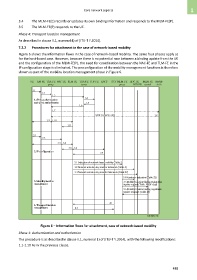Page 499 - 5G Basics - Core Network Aspects
P. 499
Core network aspects 1
3.4 The MLM-FE(C) records or updates its own binding information and responds to the MLM-FE(P).
3.5 The MLM-FE(P) responds to the UE.
Phase 4: Transport location management
As described in clause II.1, numeral 4) of [ITU-T Y.2014].
7.2.2 Procedures for attachment in the case of network-based mobility
Figure 6 shows the information flows in the case of network-based mobility. The same four phases apply as
for the host-based case. However, because there is no potential race between a binding update from the UE
and the configuration of the MLM-FE(P), the need for coordination between the NAC-FE and TLM-FE in the
IP configuration stage is eliminated. The preconfiguration of the mobility management functions is therefore
shown as part of the mobility location management phase in Figure 6.
UE AM-FE TAA-FE NAC-FE TLM-FE TAA-FE TUP-FE RACF SCF MLM-FE HDC-FE MLM-FE Mobile
proxy server proxy NID-FE central AAA
1.1
1.2
1.3
1.4
1. (Pre) authentication
and (pre) authorization 1.5
1.6
1.7
Split scenario only 1.8
1.9 1.10
1.11
2.1
2.2
2.3 2.4
2.5 2.6
2. IP configuration
2.7
3.1 Indication of network-based mobility (Table 2)
3.2 Network selection key transfer indication (Table 3)
3.3 Network selection key transfer indication (Table 27)
3.4 Handover indication (Table 22)
3. Mobility location 3.5 Mobility location binding registration
management /update request (Table 18) (if reqd)
3.6 Mobility location binding registration
/update response (Table 19)
4.1
4. Transport location
management 4.2
Y.2018(09)_F06
Figure 6 – Information flows for attachment, case of network-based mobility
Phase 1: Authentication and authorization
The procedure is as described in clause II.1, numeral 1) of [ITU-T Y.2014], with the following modifications:
1.1-1.10 As in the previous clause.
489

